Tom's Hardware Verdict
G.Skill’s Ripjaws V F4-2666C15D-16GVR may be outgunned by its competitor’s legacy kits, but as supplies of those dwindle, this one could become the best DDR4-2666 choice.
Pros
- +
XMP timings at motherboard-default 1.20V
- +
Supports manual timing reduction at 1.35V
- +
Good overall performance
- +
Nice price
Cons
- -
No secondary XMP (such as DDR4-2400)
- -
Highest non-XMP data rate is DDR4-2133
Why you can trust Tom's Hardware
In an ideal world, memory data rate limitations hinge on a CPU’s internal memory controller. But Intel’s desire to segment the market has driven the company to limit its processors based on chipset instructions. So if you want to overclock your CPU or your RAM, you’ll need a Z-series board, be that Z370 or the newer Z390. In contrast, buyers of H370- and B360-chipset motherboards get stuck with a max memory data rate of DDR4-2666. So what we’re investigating here is which modern 2666 kit is the best option for those buyers.
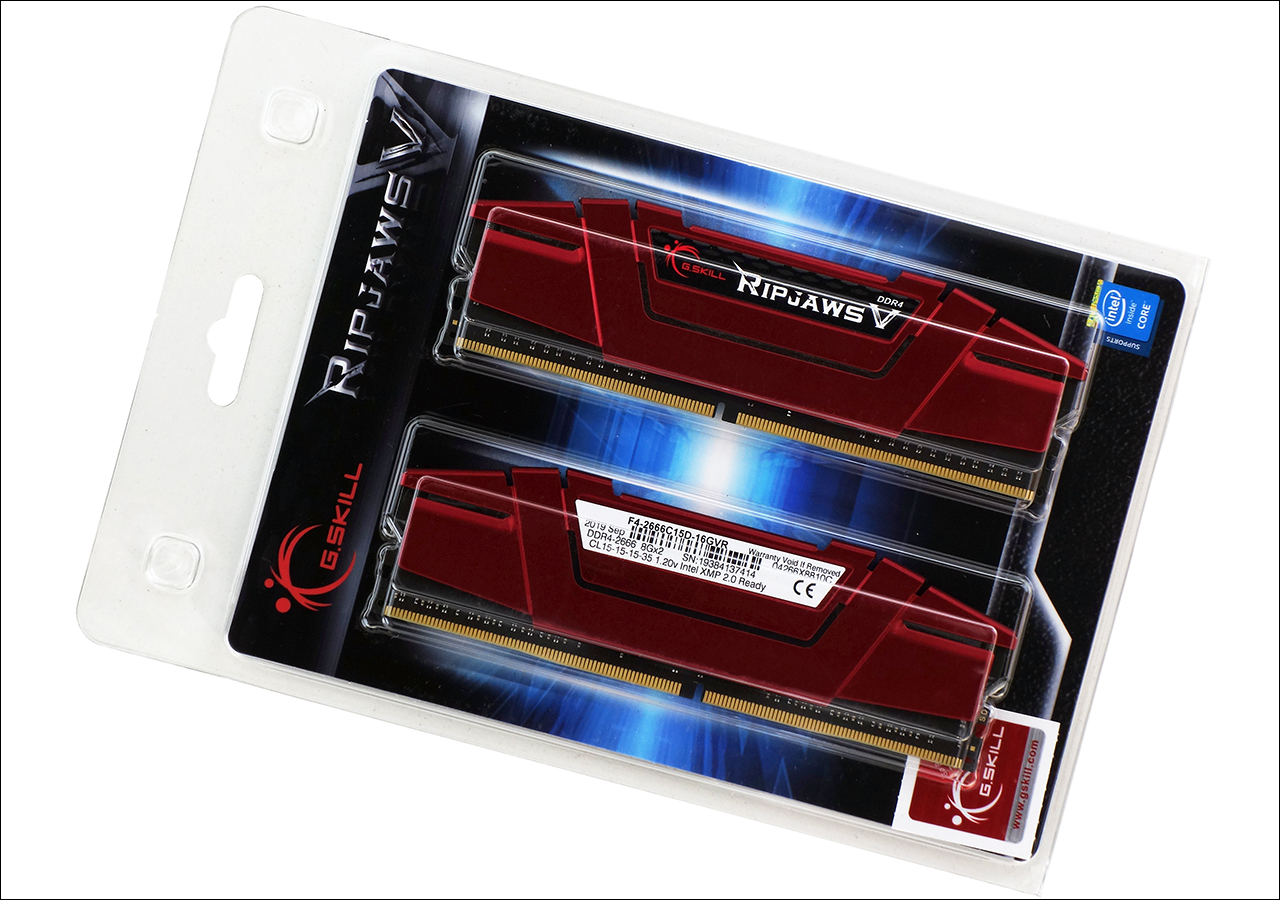
Buyers of the Ripjaws V kit get a pair of modules, a case badge, and a lifetime limited warranty that resembles every competitor in this series. The kit provides a single XMP configuration of CAS 15 at DDR4-2666, which only compares somewhat unfavorably to the 13-15-15 timings of its top competitor, the HyperX Predator DDR4-2666 16GB (HX426C13PB3K2/16). Both kits use 15 cycles for tRCD and tRP; the significance of those timings is explained in our PC Memory 101.

Having nothing better than DDR4-2133 CAS 15 to fall back on after you figure out either that your board doesn’t support XMP or your low-end CPU doesn’t support DDR4-2666 seems a bit harsh, though G.Skill at least uses the DDR4 standard 1.20 volts to assist boards in which the higher 1.35V setting may not be available. Enabling the higher data rate is simply a matter of enabling XMP when it’s available and the CPU is compliant, as outlined in our How to Choose the Right Memory.
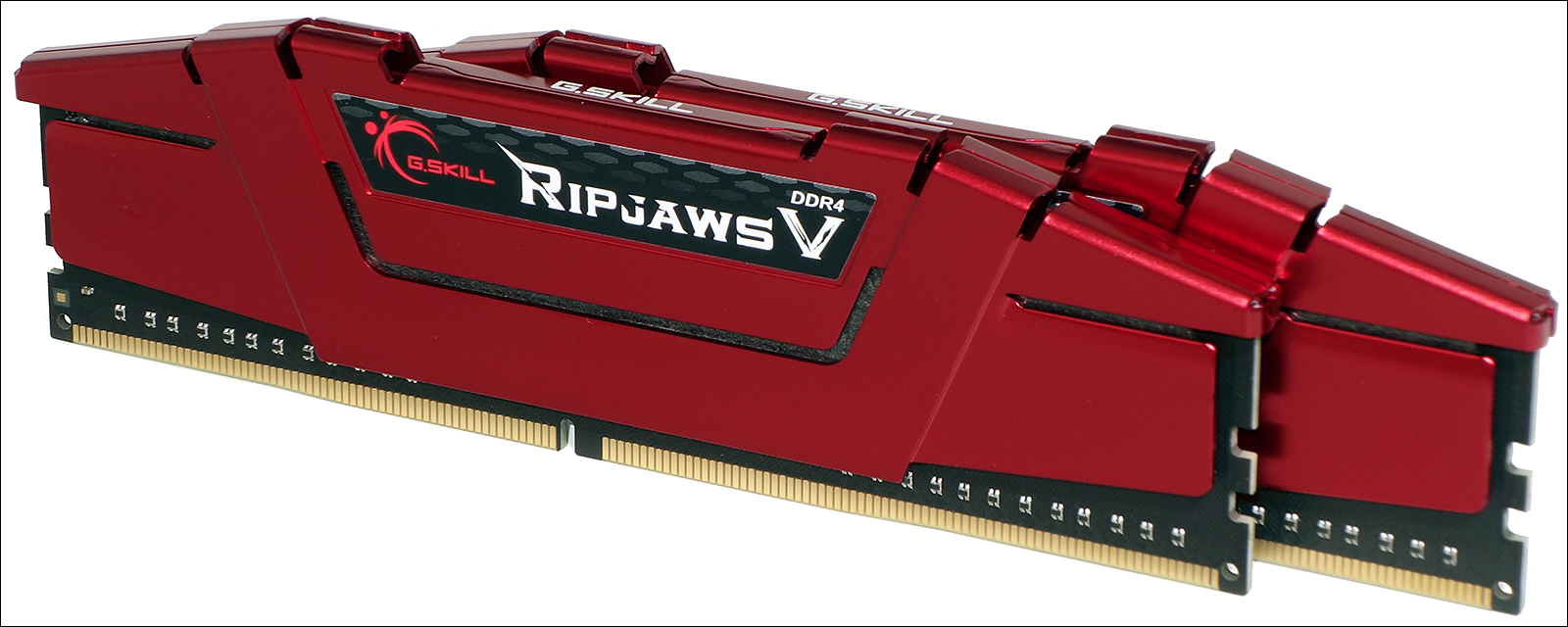
We’re comparing the Ripjaws V to the same four kits seen in our previous DDR4-2666 review. Each kit stands out in its own way, the Kingston for being the last kit we’ve seen at this frequency to support CAS 13 timings, the Corsair kit being the last we’ve seen at this capacity to have two ranks of ICs per module, the Viper Gaming kit for being the only RGB in this series, and the Ballistix Sport for being the cheapest.
Comparison Specifications
| G.Skill Ripjaws V | HyperX Predator | Corsair Vengeance LPX | Viper Gaming RGB | Ballistix Sport LT | |
|---|---|---|---|---|---|
| Part Number | F4-2666C15D-16GVR | HX426C13PB3K2/16 | CMK16GX4M2A2666C16 | PVR416G266C5K | BLS2K8G4D26BFSBK |
| Single/Dual | (2x 8GB single-rank) | (2x 8GB single-rank) | (2x 8GB dual-rank) | (2x 8GB single-rank) | (2x 8GB single-rank) |
| Capacity | 16 GB (2x 8GB) | 16 GB (2x 8GB) | 16 GB (2x 8GB) | 16 GB (2x 8GB) | 16 GB (2x 8GB) |
| XMP1 | DDR4-2666& | DDR4-2666 | DDR4-2666 | DDR4-2666 | DDR4-2666 |
| . | C15-15-15-35 | C13-15-15-35 | C16-18-18-36 | C15-17-17-35 | C16-18-18-36 |
| XMP2 | - | DDR4-2400 | - | - | - |
| . | - | C12-14-14-35 | - | - | - |
| Top Non-XMP | DDR4-2133 | DDR4-2400 | DDR4-2133 | DDR4-2133 | DDR4-2666 |
| . | C15-15-15-36 | C17-17-17-39 | C15-15-15-36 | C15-15-15-36 | C16-18-18-36 |
| XMP Voltage | 1.20 Volts | 1.35 Volts | 1.20 Volts | 1.20 Volts | 1.20 Volts |
| Warranty | Lifetime | Lifetime | Lifetime | Lifetime | Lifetime |
We continue to use our classic benchmark suite with a classic graphics card and lower-priced CPU to better match the B360/H370 target market. Intel’s Core i5-9700K is locked to 4.30 GHz for the ultimate performance consistency. MSI’s classic GTX 1080 Armor OC graphics card sets on its B360M Mortar motherboard, and Toshiba’s OCZ RD400 NVMe SSD reduces load times while assuring storage isn’t a bottleneck in our testing.
Lowest Stable Timings at 1.35V (Max) on MSI B360M Mortar BIOS 1.70 (08/08/2019)
| G.Skill Ripjaws V | HyperX Predator | Corsair Vengeance LPX | Viper Gaming RGB | Ballistix Sport LT | |
|---|---|---|---|---|---|
| Part Number | F4-2666C15D-16GVR | HX426C13PB3K2/16 | CMK16GX4M2A2666C16 | PVR416G266C5K | BLS2K8G4D26BFSBK |
| Single/Dual | (2x 8GB single-rank) | (2x 8GB single-rank) | (2x 8GB dual-rank) | (2x 8GB single-rank) | (2x 8GB single-rank) |
| DDR4-2666 | 13-15-15-30 (1T) | 13-15-15-30 (1T) | 13-14-14-28 (1T) | 14-16-16-32 (1T) | 14-16-16-32 (1T) |
| DDR4-2400 | 12-13-13-28 (1T) | 12-13-13-28 (1T) | 12-13-13-28 (1T) | 12-14-14-28 (1T) | 12-14-14-30 (1T) |
Though our platform prevents our CPU from supporting higher data rates, additional performance is available to those willing to tune their memory for quickest timings: Turning up the voltage to the same 1.35V used by HyperX, the Ripjaws V kit was stable at the same 13-15-15 timings.
Benchmark Results
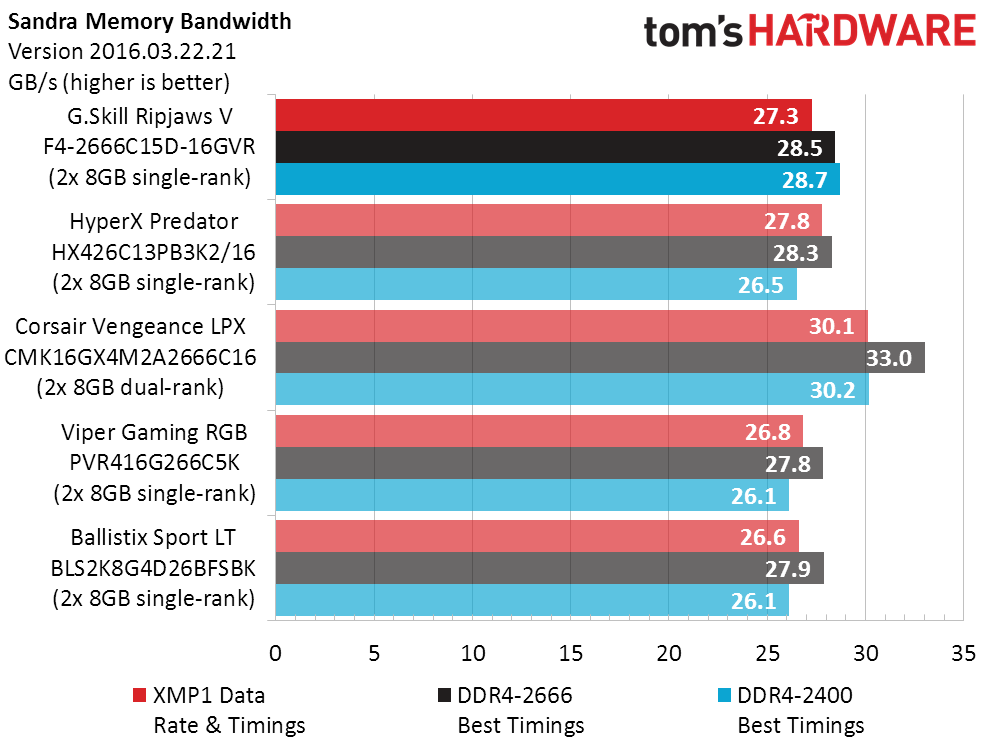

Starting off with a two-cycle CAS penalty compared to HyperX when both were set to XMP, the Ripjaws V accelerated past that lofty kit when both were tuned to their lowest stable timings. Vengeance LPX performance is in a different league regarding Sandra Bandwidth though, thanks to its use of old 4Gb ICs to fill out both ranks of each module. Conversely, high latency applies the biggest Sandra Latency penalty to Corsair’s kit.
Get Tom's Hardware's best news and in-depth reviews, straight to your inbox.
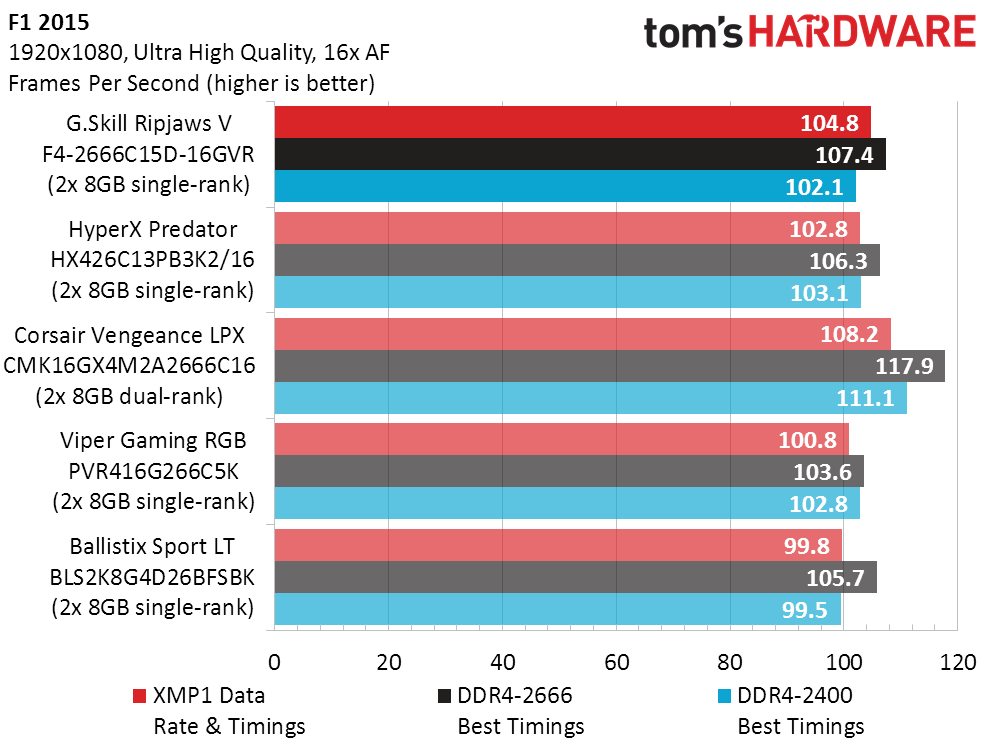
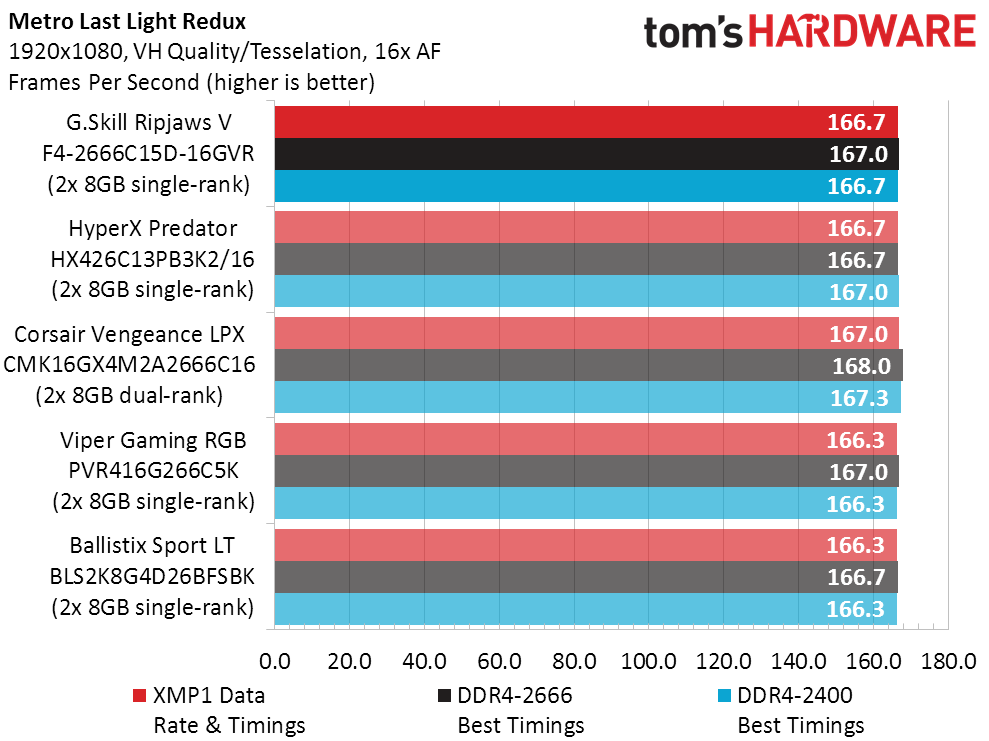
G.Skill produces the second-best performance in F1 2015, outgunned only by the doubled ranks of Corsair’s modules.

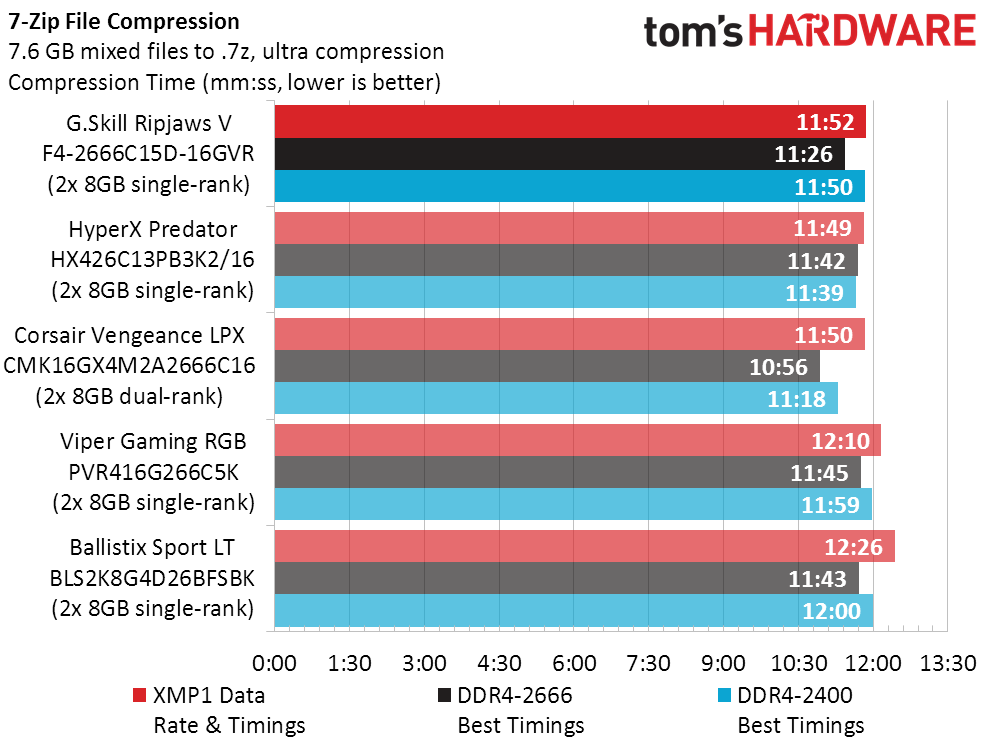
The Ripjaws V falls to third place in 7-Zip, at least when XMP is the limitation. Tightening it to HyperX timings at HyperX voltage gets it to second place, where again we see Corsair’s dual-rank configuration taking advantage of a single-rank market.
Being second-cheapest, the Ripjaws V DDR4-2666 C15 kit has the second-best value score. This, despite the Corsair kit’s performance-boosting dual-rank configuration. HyperX’s lower XMP is of little use against a price difference of roughly 20%.

Final Analysis
G.Skill’s low price puts us in an awkward position, given that the $3-cheaper Ballistix kit performs so much worse in some places, while the $6-costlier Corsair kit performs so much better in those places. Overall performance differences are miniscule in comparison to best (or worst) case scenarios, and we’re not going to let any of this stand in the way of our positive value assessment for this Ripjaws V kit.
MORE: Best Memory
MORE: DDR DRAM FAQs And Troubleshooting Guide
MORE: All Memory Content
